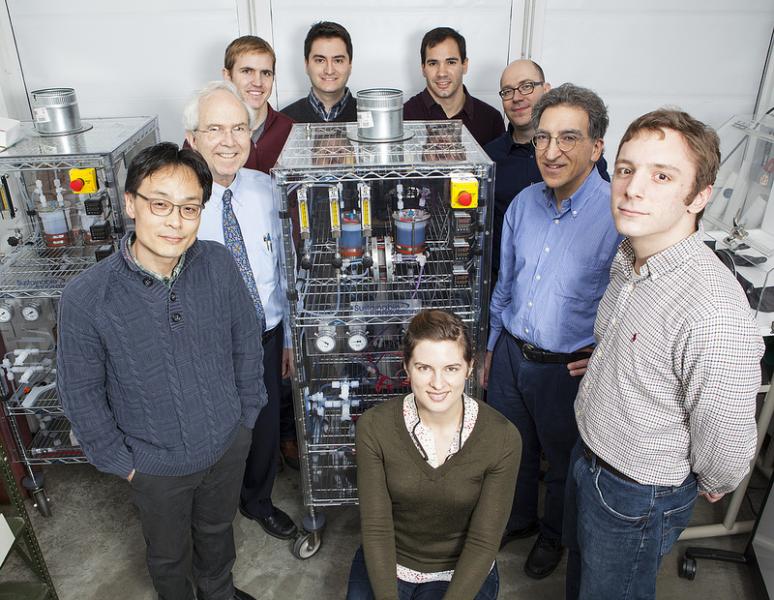I have been worried for some time that Solar just wasn't capable of competing with other power producing technologies without having a means to store power for the night, it was ok to supply peak loading during the day,that was great, but without having a good means of storing power, well I just didn't see it as being the best means of producing power that was available 24/7/365, but reading this article below, I think the time is upon us where Solar will be very competitive with all forms of energy production methods, some might even say, there goes Nuclear, yes it may be that some nuclear isn't competitive on price and the damage it can cause to the environment with used nuclear fuel, this battery technology could be the catalyst for the further decline of LEU BWR's.
Japan, just today said it was closing two nuclear plants, but some nuclear will be necessary and some of it will be very competitive also.
The world still needs to rid itself of all that used nuclear fuel sitting around in drums at nuclear plants and Plutonium like that stored at Sellafield in the UK, GEH/GLE are way ahead of the pack on this, their technology will be used, simply because it has to be, to get rid of these nuclear problems and also produce base load power cheaply, but I don't see a bright future for LEU BWR's going forward into the future somehow?
This development in flow batteries, will make Solar power very competitive especially with CPV!
http://wgsi.org/blog/energy-2030-catch-–-alán-aspuru-guzik
Energy 2030 Catch Up – Alán Aspuru-Guzik
Monday, February 2, 2015
With his recent work identified as one of the Top 100 Stories of 2014 by Discover Magazine, the beginning of 2015 has been an ideal time to catch up with Energy 2030 Contributor Alán Aspuru-Guzik.
A Professor in Harvard’s Department of Chemistry and Chemical Biology, Alán Aspuru-Guzik leads an innovative research group that focuses on, among other things, high-throughput computational materials design, quantum information and quantum computation for chemistry, and quantum effects in biology.
Column 1 0 1 Clockwise, from left: Dr. Changwon Suh, Prof. Roy G. Gordon, Dr. Brian Huskinson, Dr. Suleyman Er, Dr. Michael Marshak, Prof. Alán Aspuru-Guzik, Prof. Michael J. Aziz, Michael Gerhardt, and Lauren Hartle. (Photo by Eliza Grinnell, SEAS Communications.)
Alán and his experimental colleagues Michael Aziz and Roy Gordon, also from Harvard, are in the news for developing a metal-free organic–inorganic aqueous flow battery; a battery that has the potential to dramatically reduce the cost of large scale energy storage. Their research group has developed prototype that uses quinones – a class of carbon-containing molecules – to move electrons instead of the expensive rare metals used in conventional batteries.
Alán’s research group also leads the Harvard Clean Energy Project (CEP), a theory-driven search for the next generation of organic solar cell materials. By using donated computer idle time to assess computer models of millions of molecules, the CEP identifies compounds that are suitable for capturing solar energy. It is the largest-ever computational study using quantum chemistry.
- Forums
- ASX - By Stock
- SLX
- Harvard Quinone Flow Battery
Harvard Quinone Flow Battery
-
- There are more pages in this discussion • 4 more messages in this thread...
You’re viewing a single post only. To view the entire thread just sign in or Join Now (FREE)
Featured News
Add SLX (ASX) to my watchlist
 (20min delay) (20min delay)
|
|||||
|
Last
$5.33 |
Change
0.260(5.13%) |
Mkt cap ! $1.262B | |||
| Open | High | Low | Value | Volume |
| $5.12 | $5.33 | $5.01 | $4.811M | 914.2K |
Buyers (Bids)
| No. | Vol. | Price($) |
|---|---|---|
| 1 | 336 | $5.29 |
Sellers (Offers)
| Price($) | Vol. | No. |
|---|---|---|
| $5.34 | 1698 | 1 |
View Market Depth
| No. | Vol. | Price($) |
|---|---|---|
| 1 | 1500 | 5.170 |
| 1 | 2000 | 5.030 |
| 1 | 200 | 5.010 |
| 2 | 13000 | 5.000 |
| 1 | 1904 | 4.980 |
| Price($) | Vol. | No. |
|---|---|---|
| 5.500 | 368 | 1 |
| 5.550 | 350 | 1 |
| 5.600 | 3209 | 3 |
| 5.650 | 2625 | 1 |
| 5.840 | 3092 | 1 |
| Last trade - 16.10pm 28/06/2024 (20 minute delay) ? |
Featured News
| SLX (ASX) Chart |
The Watchlist
LU7
LITHIUM UNIVERSE LIMITED
Alex Hanly, CEO
Alex Hanly
CEO
SPONSORED BY The Market Online










